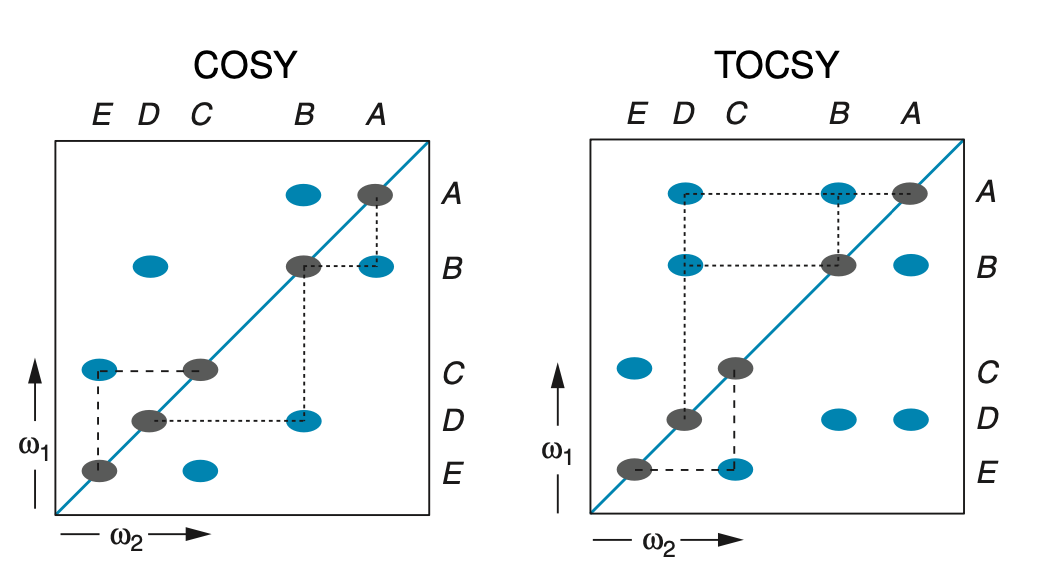I like to compare TOCSY with gossip. It does not matter if Hydrogens 1 (H1) and H3 are scalar coupled; if H1 is coupled to H2 and H2 is coupled to H3, we will observe a correlation between H1-H3. However, this transmission is broken if there's an interruption of "communication": J=0 or close to zero. Usually, the presence of a heteroatom interrupts the TOCSY transfers.
The situation above looks precisely like gossip; it does not matter if you talk to person 3 or not, if person 2 talks to both of you and passes the information back and forth.
Suppose we have a molecule composed of two spin systems:
- I) Formed by hydrogens A, B, and D. A is scalar coupled to B, B is scalar coupled to D, but A and D are not coupled to each other.
- II) Formed by C and E.
This is how the 1H-1H TOCSY would look like:
(Special Thanks to Prof. James Keeler who allowed me to use his amazing figures: Understanding NMR Spectroscopy, Second Edition. James Keeler).
Extremely useful for assigning hydrogens on sugars rings and identifying different residues on peptides, a general TOCSY pulse sequence is composed of the following parts:
1. First 90˚ pulse that brings the magnetization to the transverse plane;
2. A variable t1 delay to generate the second dimension [Bruker: d0 + n*in0; n = 0, 1, 2… TD(F1)];
3. Second 90˚ pulse
4. Isotropic mixing time (spin-lock): composed of a series of low power pulses, it allows the spins to transfer the information from one another through scalar-coupling. The longer the mixing time farther away in the chain the transfer can reach (usually up to 6 bonds). Typical duration of the mixing time (D9 – Bruker): 20 – 80 ms.
5. Third 90˚ pulse that brings the magnetization back to the transverse plane.
For those interested in Water suppression, I would suggest the following pulse sequences:
Phase-sensitive sensitivity-improved 2D TOCSY with WATERGATE (3-9-19) and using DIPSI-2 (dipsi2etgpsi19)
Phase-sensitive 2D TOCSY with excitation sculpting (180 water-selective pulse-ES element) using DIPSI-2 (dipsi2esgpph)
Phase-sensitive 2D TOCSY with excitation sculpting (180 water-selective pulse-ES element) using DIPSI-2 and optional 13C,15N-decoupling (dipsi2esfbgpph).
TOCSY Applications:
- Identification of residues on peptides.
http://www.bp.uni-bayreuth.de/NMR/nmr_aminotocsy.html
http://www.bp.uni-bayreuth.de/NMR/nmr_alltocsy.html
- Identification of spin systems in mixture of small molecules. In this case, 1D selective TOCSY is great!!
- Protein side-chain assignment: HCCH-TOCSY (Future Topic).
- Protein-ligand interaction – Filtered experiments (Future Topic).


